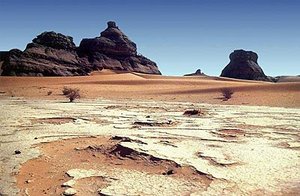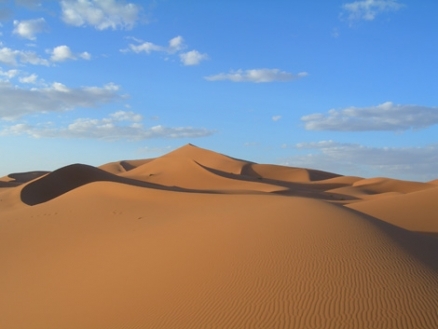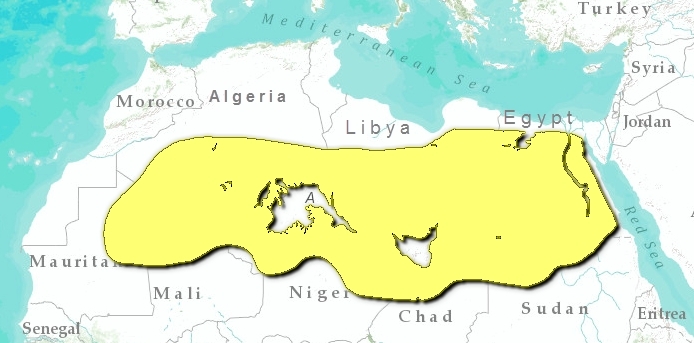Sahara Desert
The Sahara Desert is the largest hot desert in the world and occupies approximately ten percent of the African continent. The ecoregion includes the hyper-arid central portion of the Sahara where rainfall is minimal and sporadic. Although species richness and endemism are low, some highly adapted species do survive with notable adaptations. Only a few thousand years ago the Sahara was significantly wetter, and a significant large mammal fauna resided in this area. Climatic desiccation over the past 5000 years, and intense human hunting over the past 100 years, has obliterated most of these fauna. Now, in vast portions of the Sahara, merely rock, sand and sparse vegetation are found. The remnant large mammalian fauna is highly threatened by ongoing over-hunting. An alternative name of the Sahara is the Great Desert.
Formation, Location and General Description
From the Atlantic Ocean in the west, the greater Sahara stretches across Africa to the Red Sea and down to the highlands of Ethiopia, encompassing an area 9,100,000 square kilometres (km2). This ecoregion covers the central Sahara Desert, between 18° and 30° N, and has an area of 4,619,260 km2. The northern and southern margins of the Sahara, which receive greater rainfall and have greater vegetation cover, are described separately.
The surface of the desert ranges from large areas of sand dunes (erg Chech, Raoui), to stone plateaus (hamadas), gravel plains (reg), dry valleys (wadis), and salt flats. Several deeply dissected mountain massifs (Ahaggar, Tassili N'Ajjer, Tibesti, and Aïr) rise from the desert areas, and are delineated as separate ecoregions. Vast underground aquifers underlying much of the region sometimes penetrate the surface, resulting in oases.
The Sahara is located in a climatic divide. The Intercontinental Convergence Zone moves up from the south, but stops before the center of the Sahara, and consequently hardly carries any rain. Similarly, the winter rainfall of North Africa does not reach far south enough to regularly bring rain to the central Sahara. Consequently, the rainfall, albeit extremely rare, can fall in any season. The annual rainfall is below 25 millimetres (mm), and in the eastern part of the desert it is less than five mm per annum. The scarcity of rainfall in this ecoregion is aggravated by its irregularity, as no rain may occur for many y in some areas, followed by a single intense thunderstorm.
The Sahara is one of the hottest regions in the world, with mean annual temperatures exceeding 30°C. earsIn the hottest months, temperatures can rise over 50°C, and temperatures can fall below freezing in the winter. A single daily variation of -0.5°C to 37.5°C has been recorded. The Sahara is also extremely windy. Hot, dust-filled winds create dust devils which can make the temperatures seem even hotter.
 Libya. (Photograph by SaharaMet)
Libya. (Photograph by SaharaMet) The extreme aridity of this area is a relatively recent feature. Much larger areas of the Sahara had adequate water only 5000 to 8000 years ago. It is not clear how much of this ecoregion was covered with vegetation, but in other parts of the Sahara the vegetation was closer to the savanna woodlands of eastern and southern Africa. Currently the ecoregion is in a "hyper arid" phase, with high summer temperatures, lower winter temperatures and rainfall between 0 and 25 mm per annum. There are two theories of the formation of the Sahara, but in any case its formation is recent, beginning circa 8000 to 4000 years before present. One theory relates to subtle natural changes in the Earth orbit, leading to dramatically reduced rainfall in the region. The second theory, supported by extensive archaeological and plant record data, indicates Holocene man engaged in steadily expanding pastoralism, leading to overgrazing and corresponding changes in land cover and albedo.
Precambrian rocks are exposed in few places across the Sahara. During the Mesozoic much of North Africa was under water and marine deposits were deposited. The area was uplifted in the Middle Tertiary and has been eroding ever since. Shifting sands and bare rocks cover only about one-fifth of the greater Sahara. More than half of the area comprises soils known as yermosols, with shallow profiles over gravel or pebble beds. These soils have been developing over the past 50 million years.
In terms of the phytogeographical classification of White, the ecoregion is classified as the Sahara regional transition zone. Throughout most of the ecoregion there is very little perennial vegetation. Where it occurs, it is confined to areas where groundwater reaches the surface or to areas with runoff. The plants that are present tend to be much more diversified in western Sahara than eastern Sahara, due to the lack of rain to the east. They have strictly Sahara-Arabian affinities, with exceptional adaptations to aridity. Large expanses of ergs (dunes) and regs will be devoid of any visible plant life for years, but following rainfall, vegetation cover may reach more than 50 percent on sand dunes and 20 percent on the gravel plains.
Biodiversity Features
The flora of the central Sahara Desert is quite depauperate, and is estimated to include only 500 species. This is extremely low considering the huge extent of the area. It mainly consists of xerophytes and ephemeral plants (called also locally Acheb), with halophytes in moister areas. The flora has one near endemic family, a number of isolated monotypic genera of both wide and narrow distribution, and perhaps as many as 162 endemic species. The monotypic genera suggest a Tertiary origin with probable extinction of linking forms. Vegetation is very contracted along the wadis and the dayas with Acacia sp, Tamarix sp., and Calotropis procera. Where there is sufficient groundwater, hammadas are covered by Anrthirrnum ramosissimuma and Ononis angustissima.
Considering the hyper-arid conditions, the fauna of the central Sahara is richer than is generally believed. Within this ecoregion there are 70 species of mammal, 20 of which are large mammals. There are also 90 species of resident birds, and around 100 species of reptiles. Arthropods are also numerous, especially ants. One of the bird species (Oenanthe monacha) is regarded as endemic to the ecoregion, and there is one strictly endemic currently undescribed worm snake (Leptotyphlops sp nov. "L"). However, given the vast size of the ecoregion, the number of endemic species is very small.
In the past the critically threatened addax (Addax nasomaculatus) would probably have occurred in this ecoregion, but this species is likely to be extirpated. Small numbers of scimiter-horned oryx (Oryx dammah, EX) may have also occurred in the past. Other desert antelopes may still be found in small numbers, such as slender-horned gazelle (Gazella leptoceros, EN), dama gazelle (Gazella dama, EN) and the red-fronted gazelle (Gazella rufifrons, VU).
The plants and animals of the Sahara are more threatened by desiccation than fauna and flora in other areas. Plant leaves may dry out totally and then recover; animals may loose 30 to 60 percent of their body mass and are still able to recover. Many of the animals obtain their water only through metabolic processes. These kinds of adaptations have allowed them to survive in such an inhospitable environment.
Current Status
The Sahara is a vast area of largely undisturbed habitat, principally sand and rock, but with small areas of permanent vegetation. The most degradation is found where water (oases, etc) is present. Here, [[habitat]s] may be heavily altered by human activities. Previously existing tree cover has often been removed for fuel and fodder by nomadic pastoralists and traders.
From a conservation perspective, the Sahara Desert is not well protected. Yet, this may be due to the low population and impracticality of defining borders over this vast area. Fewer than two million inhabitants reside throughout the entire Sahara Desert. The majority are nomads, predominantly the Tuareg, Tibbu, and Moors. They survive by nomadic pastoralism, hunting, and trading. Most of these people are found in the desert margins and they do not often spend much time in the central hyper-arid portion. Only one protected area is recorded in the Sahara: Zellaf Nature Reserve in Libya (1000 km2).
Types and Severity of Threats
The ephemeral [[habitat]s] of the Sahara, which only develop following rainfall, are not highly threatened by human activities. The more persistent pressures are found in areas of permanent water (oases), or in areas where water comes close to the surface. Here, the local pressure on natural resources can be intense. There is also an intense pressure on any remaining [[population]s] of large mammals adapted to desert conditions. The populations of all such species have been greatly reduced by hunting for food, and also through hunting for sport and recreation. The addax (Addax nsaomaculatus) is now critically threatened with extinction, mainly due to intense over-hunting, and most of the other desert-adapted antelopes that may still occur in the ecoregion are endangered.
In recent years development projects have started in the deserts of Algeria and Tunisia using irrigated water pumped from underground aquifers. These schemes often lead to soil degradation and salinization because of "drainage" problems.
Justification of Ecoregion Delineation
The borders for this ecoregion follow "desert dunes with perennial vegetation" and "absolute desert," mapped by White, and correspond approximately to the region with less than 25 mm of mean annual rainfall. The northern and southern margins of the Sahara, which receive more rainfall and have greater vegetation cover, are delineated separately as the North and South Saharan Steppe and Woodlands. The ecoregion also forms a majority of the Sahara biogeographic province of Udvardy.
Further Reading
- Climap 1976. The surface of the ice age earth. Science 191: 1131-1144.
- Cloudsley-Thompson, J.L. 1984. Sahara Desert. Perhamon Press, Oxford. ISBN: 0080288693
- Davis, S.D., V.H. Heywood and A.C. Hamilton, editors. 1994. Centres of Plant Diversity. A Guide and Strategy for their Conservation. Volume 1. Europe, Africa, South West Asia and the Middle East. IUCN Publications Unit, Cambridge, U.K. 354 pp.
- Le Houérou, H.N. 1990. Recherches écoclimatique et biogéographique sur les zones arides de L'Afrique du Nord. CEPE/CNRS, Montpellier, 600pp.
- Le Houérou, H.N. 1991. Outline of a Biological History of the Sahara. Pages 146-174 in J.A. McNeely and V.M. Neronov, editors. Mammals in the Palaearctic Desert: status and trends in the Sahara-Gobian region. The Russian Acedemy of Sciences, and the Russian Committee for the UNESCO programme on Man and the Biosphere (MAB).
- Ozenda, P. 1983. Flore du Sahara. Pages 21-32 en Editions du Centre National de la Recherche Scientifique (CNRS), Paris. ISBN: 2222002923
- Quézel, P. 1965. La vegetation du Sahara, du Tchad a la Mauritanie. Fisher Verlag, Stuttgart. 333pp.
- Williams, M.A.J. and H. Faure, editors. 1980. The Sahara and the Nile. Balkema, Rotterdam. ISBN: 9061910196
- White, F. 1983. The vegetation of Africa: a descriptive memoir to accompany the UNESCO/AETFAT/UNSO vegetation map of Africa. UNESCO, Paris, France. ISBN: 9231019554
- Zahoran, M.A. and A.J. Willis. 1992. The Vegetation of Egypt. Chapman and Hall, London. ISBN: 0412315106
- For a terser summary of this entry, see the WWF WildWorld profile of this ecoregion.
| Disclaimer: This article contains information that was originally published by the World Wildlife Fund. Topic editors and authors for the Encyclopedia of Earth have edited its content and added new information. The use of information from the World Wildlife Fund should not be construed as support for or endorsement by that organization for any new information added by EoE personnel, or for any editing of the original content. |



